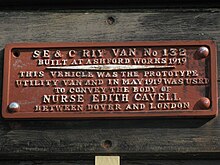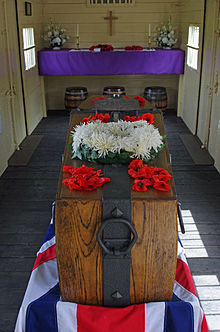Cavell Van
| Cavell Van | |
|---|---|
|
Cavell Van after restoration
|
|
| Numbering: | 132 374S DS374 082757 |
| Number: | 1 piece |
| Year of construction (s): | 1919 |
| Type : | Passenger carriage type |
| Gauge : | 1435 mm (4 feet 8 ½ inches ) |
The Cavell Van is the prototype baggage cart built by the South Eastern and Chatham Railway in 1919 . In it the remains of Edith Cavell were transported from Dover to London after they were exhumed in 1919 and transferred to Great Britain.
The Cavell Van also transported the remains of Charles Fryatt and the Unknown Soldier from Dover to London.
history
In the 1920s, 30s and 40s, the car was used in the regular service of the Southern Railway as the successor to the South Eastern and Chatham Railway. From August 1946 the car was used as a warehouse and as a transport car for workers and tools and was given new numbers several times. The last time the car was in service at the Guildford depot began in 1967 .
The car went to the Kent & East Sussex Railway in 1992 and has been extensively restored. From 1994, the car was first owned by the Rother Valley Railway and subsequently changed hands several times. In 2003 the car was bought by a member of the Kent & East Sussex Railway. In 2010 the car was again and comprehensively restored and returned to its original condition and has since been viewed as a museum car at various locations.
Edith Cavell
Edith Cavell was a British nurse who had lived in Belgium since 1907 . During the First World War she helped British soldiers flee Germany- occupied Belgium to the neutral Netherlands . Before she was arrested by the Germans on August 5, 1915, she helped about 200 British soldiers to flee. She was sentenced to death and executed on October 12, 1915. In 1919 she was exhumed and her remains transferred to Great Britain. The wagon later named after her was used for the transport from Dover to London.
Charles Fryatt
Charles Fryatt was a captain during World War I. One of the ships he commanded, the SS Wrexham, was attacked by a German submarine on March 3, 1915. However, Fryatt escaped at full speed and rescued his ship in the port of Rotterdam in the neutral Netherlands . On March 28, 1915 he was the captain of the SS Brussels, which was attacked by U-33 . Fryatt headed for the German submarine and tried to ram it. U-33 could only escape this maneuver by diving into alarm . Over a year later, on June 22, 1916, the SS Brussels was attacked by five German destroyers and Fryatt was captured. His case was tried in court from July 16, charged with franc-shooter , which was used to denote attacks by civilians on members of the military during the First World War. He was sentenced to death by shooting and executed on July 27, 1916. After the war, his body was exhumed and transferred to Great Britain. The transport between Dover and London took place in the Cavell Van.
The Unknown Soldier
As already happened with Cavell and Fryatt, the remains of the Unknown Soldier were brought from Dover to London in the Cavell Van. The Unknown Soldier is a British soldier of unknown origin who died in Europe during the First World War. In 1920 his remains were exhumed, transferred to Great Britain and buried in Westminster Abbey . The grave of the Unknown Soldier is now located near the entrance in the floor of the church.
restoration
A call for funds was launched in December 2009 to raise £ 35,000 for the restoration of the car. The work was completed in time for November 10, 2010, exactly 90 years after the Unknown Soldier was transported in the Cavell Van.
Whereabouts
Most of the time, the restored car is parked at the terminus of the Kent and East Sussex Railway in Bodiam, southern England , near Bodiam Castle and can also be viewed there.
Web links
Individual evidence
- ↑ a b c d Kent & East Sussex Railway - Cavell Van on kesr.org.uk (web archive), accessed November 1, 2018
- ↑ Edith Cavells life on edithcavell.org.uk, accessed November 1, 2018
- ↑ Captain Fryatt: forgotten martyr of the first world was on nationalarchives.gov.uk, accessed on November 1, 2018
- ↑ a b Bid to save WW1 heroes carriage on bbc.co.uk, accessed on November 1, 2018
- ↑ 100 years ago: Edith Cavell executed in Brussels on vrt.be, accessed on October 31, 2018



